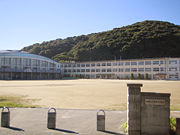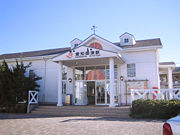
Mito, Aichi
Encyclopedia
.jpg)

.jpg)

Towns of Japan
A town is a local administrative unit in Japan. It is a local public body along with prefecture , city , and village...
located in Hoi District
Hoi District, Aichi
is a former rural district located in eastern Aichi Prefecture, Japan.As of 2008 , the district had an estimated population of 21,766 and a population density of 2194 persons per km². Its total area was 9.92 km².-History:...
, Aichi
Aichi Prefecture
is a prefecture of Japan located in the Chūbu region. The region of Aichi is also known as the Tōkai region. The capital is Nagoya. It is the focus of the Chūkyō Metropolitan Area.- History :...
, Japan
Japan
Japan is an island nation in East Asia. Located in the Pacific Ocean, it lies to the east of the Sea of Japan, China, North Korea, South Korea and Russia, stretching from the Sea of Okhotsk in the north to the East China Sea and Taiwan in the south...
.
On January 15, 2008 Mito was merged
Merger and dissolution of municipalities of Japan
Municipal mergers and dissolutions carried out in Japan can take place within one municipality or between multiple municipalities and are required to be based upon consensus.- Merger policy:...
with the city of Toyokawa
Toyokawa, Aichi
is a medium-sized city of about 180,000 people located in the eastern part of Aichi Prefecture, Japan. The city, founded on June 1, 1943, originally comprised the three formerly independent Hoi-gun towns of Toyokawa , Ko , Ushikubo , and the village of Yawata...
.
As of 2007 (the last data available prior to the merger), the town had an estimated population
Population
A population is all the organisms that both belong to the same group or species and live in the same geographical area. The area that is used to define a sexual population is such that inter-breeding is possible between any pair within the area and more probable than cross-breeding with individuals...
of 13,536 and a population density
Population density
Population density is a measurement of population per unit area or unit volume. It is frequently applied to living organisms, and particularly to humans...
of 722.69 persons per km². The total area was 18.73 km².
History
The area around Mito has been settled since prehistoric times, and archaelogists have found numerous remains from the JomonJomon period
The is the time in Japanese prehistory from about 14,000 BC to 300 BC.The term jōmon means "cord-patterned" in Japanese. This refers to the pottery style characteristic of the Jōmon culture, and which has markings made using sticks with cords wrapped around them...
, Yayoi
Yayoi period
The is an Iron Age era in the history of Japan traditionally dated 300 BC to 300 AD. It is named after the neighbourhood of Tokyo where archaeologists first uncovered artifacts and features from that era. Distinguishing characteristics of the Yayoi period include the appearance of new...
and Kofun period
Kofun period
The is an era in the history of Japan from around 250 to 538. It follows the Yayoi period. The word kofun is Japanese for the type of burial mounds dating from this era. The Kofun and the subsequent Asuka periods are sometimes referred to collectively as the Yamato period...
s.
- 1930: Mito Town was founded.
- 1939: Symbol of Mito was established.
- 1947: Mito Junior High School was founded. Goyu Station changed its name to Aichi-Mito StationAichi-Mito Stationis a railway station on the Tōkaidō Main Line of Central Japan Railway Company in Toyokawa, Aichi Prefecture, Japan. The station is 302.1 rail kilometers from Tokyo Station.- Station history:...
. - 1976: New town office was completed.
- 1979: Crematory was completed.
- 1980: Ceremony to celebrate the 50th anniversary of the founding Mito Town was held.
- 1986: Mito High School was founded.
- 1989: Miyukihana Putting Course (御幸浜パターゴルフ場) was founded.
- 1992: Mt. Mito promenade (御津山遊歩道) was completed. Water purification plant was completed.
- 1995: Heartful Hall was completed.
- 1996: The 1st Mito Festival (みとまつり Mito Matsuri) was held.
- 2000: Walfare and Health Center opened.
- October 2, 2007: Mito Town Library opened in the Heartful Hall.
- January 15, 2008: Mito Town was incorporated into Toyokawa CityToyokawa, Aichiis a medium-sized city of about 180,000 people located in the eastern part of Aichi Prefecture, Japan. The city, founded on June 1, 1943, originally comprised the three formerly independent Hoi-gun towns of Toyokawa , Ko , Ushikubo , and the village of Yawata...
.
Railway
- Central Japan Railway CompanyCentral Japan Railway CompanyThe is the main railway company operating in the Chūbu region of central Japan. It is officially abbreviated in English as JR Central and in Japanese as . Its headquarters are located in the JR Central Towers in Nakamura-ku, Nagoya, Aichi Prefecture.The company's operational hub is Nagoya Station...
- Tōkaidō Main LineTokaido Main LineThe is the busiest trunk line of the Japan Railways Group , connecting Tōkyō and Kōbe stations. It is long, not counting its many freight feeder lines around the major cities...
- Aichi-Mito StationAichi-Mito Stationis a railway station on the Tōkaidō Main Line of Central Japan Railway Company in Toyokawa, Aichi Prefecture, Japan. The station is 302.1 rail kilometers from Tokyo Station.- Station history:...
- Tōkaidō Main Line
- Nagoya RailroadNagoya Railroad, often abbreviated as , is a railroad company operating around Aichi Prefecture and Gifu Prefecture of Japan.Some of the more famous trains operated by Nagoya Railroad include the Panorama Car and the Panorama Car Super, both of which offer views through their wide front windows...
- Meitetsu Nagoya Main Line - Odabuchi StationOdabuchi Stationis a train station on the Meitetsu Nagoya Main Line located in Toyokawa, Aichi, Japan. It is located 6.6 kilometers from the junction of the Nagoya Main Line at .-History:...
(This station is located in Toyokawa, but it is near to Kamisawaki, Mito)
- Meitetsu Nagoya Main Line - Odabuchi Station
Local attractions
- Daionji Temple (大恩寺)
- Mt. Mito (御津山)
- Miyukihama (御幸浜)
- Ruins of the Takemoto Castle (竹本城址)
- Mikawa Coastal Green Tract (三河臨海緑地)
- Mikawa-Mito Marina (三河御津マリーナ)

